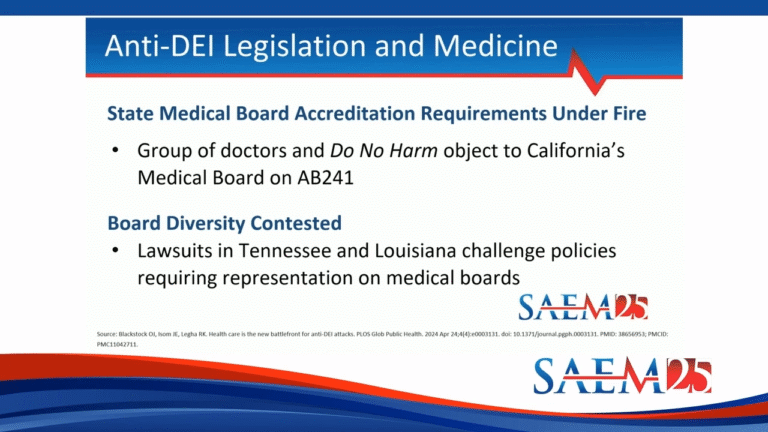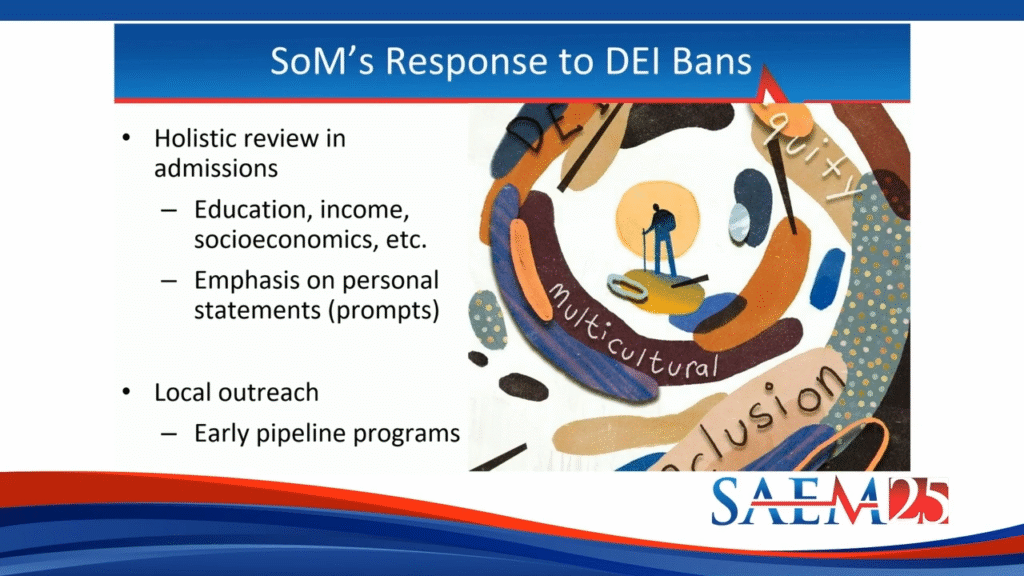Commentary
The Society for Academic Emergency Medicine Hosts DEI Activism Discussion
Share:

Earlier this year, the Society for Academic Emergency Medicine (SAEM) hosted a discussion overviewing recent laws restricting DEI – and discussing strategies to skirt these new policies. SAEM is a membership organization representing clinicians, educators, students, and others involved in academic emergency medicine.
The discussion, titled “Shhh! Don’t Say DEI: An Open Dialogue to Address DEI in Academic Emergency Medicine” focused on the impact of legislation, litigation, and other efforts that prevent medical schools from engaging in discriminatory behavior.
According to the video description, the goals of the event included: “discuss strategies used by residencies that successfully maintained or expanded DEI efforts despite opposition”; “discuss approaches to creating psychologically safe spaces for trainees to discuss DEI concerns”; and “discuss collaborative ways to sustain DEI work in the face of institutional and political challenges.”
In other words, the discussion would focus on ways in which medical schools could continue DEI activities despite recent legislation, executive orders, and the Supreme Court’s decision in Students for Fair Admission v. Harvard that race-based admissions are unconstitutional.
Although the speakers identified themselves at the start of the discussion, due to the audio quality of the recording coupled with Do No Harm’s interest in accuracy, Do No Harm has refrained from attributing specific quotes to individual speakers.
The discussion began with an ostensible justification for DEI in medical education: the theory that racial concordance – when patients are treated by physicians of the same race – improves health outcomes.
“It’s known that whenever you have a patient and a provider and they look similar or they share an identity characteristic, something really powerful happens,” one of the speakers began.
“And it’s not just about these behavioral changes; it’s literally about survival,” the speaker continued. “So, black newborns are more than twice as likely to survive whenever they are cared for by a black physician. It also increases lifespan.”
First, the argument that racial concordance improves health outcomes is not supported by the existing evidence. As Do No Harm’s own research has shown, five out of six systematic reviews find that racial concordance has no impact on health outcomes
Second, the claim referring to black newborn mortality appears to be referring to a long-debunked study, “Physician–patient racial concordance and disparities in birthing mortality for newborns,” which found no race concordant effect when the proper controls were applied.
Nevertheless, the speaker repeats arguments for racial concordance further on in the video, arguing that DEI programming and a more diverse student body contribute to better health outcomes.
“So, it is known that at med schools where they have more DEI programming, that the student body is more diverse,” the speaker said. “We already showed, diverse student body, diverse physicians; better patient outcomes, better science.”
Again, the premise of this argument is the notion that minority patients receive better care when treated by physicians of the same race.
This is simply false.
Further in the discussion, another speaker discusses “anti-DEI” litigation and legislation, explicitly mentioning efforts by Do No Harm.
The speaker mentions Do No Harm’s ongoing effort to challenge California’s law requiring all continuing medical education (CME) courses involving direct patient care to include implicit bias training.
Next, the speaker refers to litigation challenging state laws requiring that medical boards contain racial minorities. Do No Harm sued Tennessee over its racial quota law, and dismissed its lawsuit after Tennessee passed legislation removing the discriminatory requirement.
Racial quotas, by definition, prioritize innate characteristics over aptitude and merit. Medical boards cannot properly safeguard public health when membership is based on the color of board members’ skin over medical expertise. Moreover, treating people differently on the basis of race violates the very notion of equality before the law.

“California currently has AB241, which is a requirement that all physicians, in order to be recertified every two years, have to undergo one single hour of implicit bias training,” the speaker said. “However, a group of doctors, and also the nonprofit Do No Harm […] are actually suing the California medical board to get that requirement removed.”
In actuality, the law requires that all CME include implicit bias training; a far cry from one single hour. To be clear, there is no evidence supporting the claim that these perceived “biases” have any impact on real-world health outcomes.
The final part of the discussion centered on strategies medical schools could take to continue implementing DEI and achieving diversity goals.
These included “local outreach” and “holistic review,” in which schools de-emphasize the metrics that should determine admission to medical school (e.g., GPA and MCAT scores) and place greater focus on other non-merit-related factors such as socioeconomic background or personality traits.
One speaker noted that these strategies could further diversity goals, with personal statements by applicants used as a proxy for determining their “diverse” status.
As the speaker put it, medical school admissions departments are “placing more of an emphasis and more points on personal statements in the prompts and how people answer questions, how they do in interviews, and so forth.”

The speaker later discussed strategies that emergency medicine departments in medical schools are employing to deal with DEI bans, including scrubbing websites to remove mentions of DEI.
In short, SAEM should not be agitating against efforts to remove divisive, discriminatory practices and policies from medical education.
Eliminating these discriminatory abuses is necessary to promote excellence and merit in the medical field.


